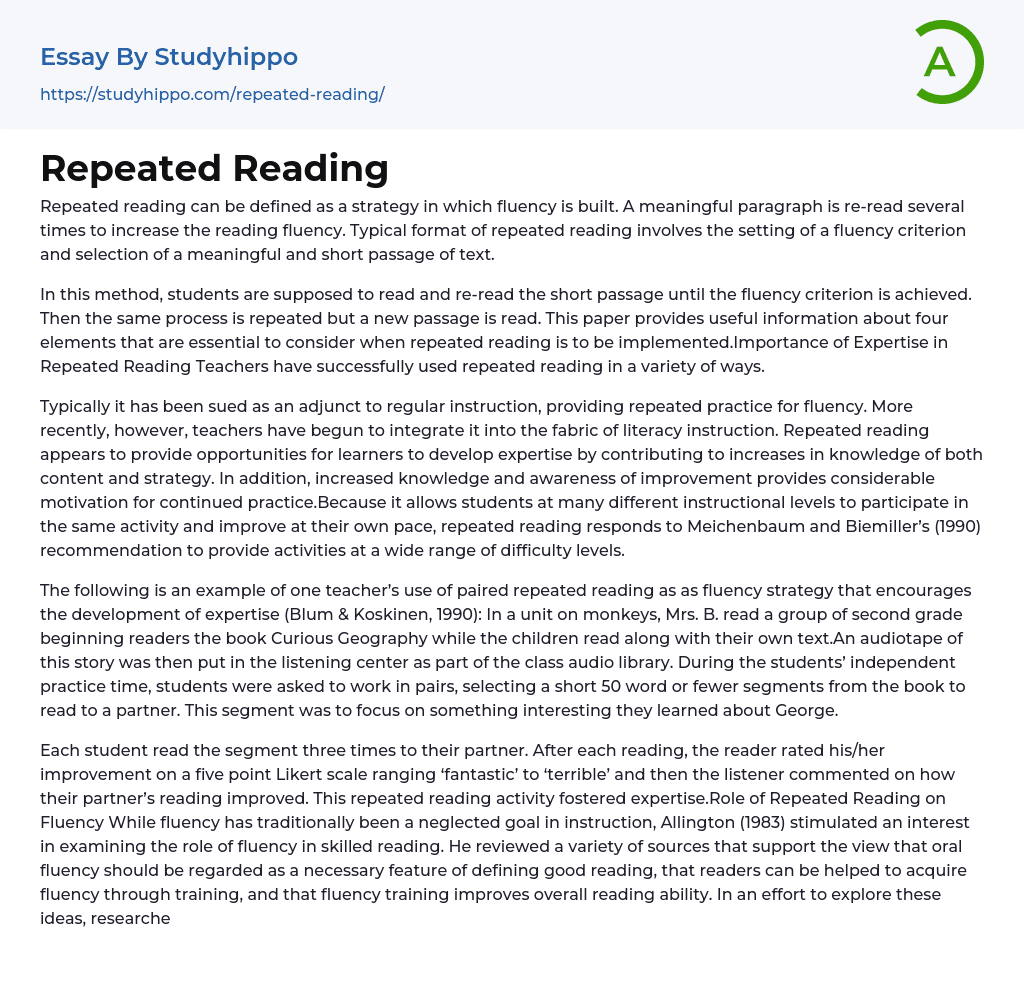Repeated reading is a strategy that focuses on building fluency. It involves re-reading a meaningful paragraph multiple times to improve reading fluency. The typical format for repeated reading includes setting a fluency criterion and choosing a short passage of text. Students are then expected to read and re-read the passage until they reach the fluency criterion.
Then, the text emphasizes the importance of expertise in repeated reading. Teachers have effectively utilized repeated reading in various ways. It has traditionally been used as an additional tool alongside regular instruction to enhance fluency through repeated practice. However, more recently, teachers have started to incorporate it seamlessly into literacy instruction. Repeated reading seems to offer learners possibilities for acquiring expertise by enhancing their understanding of content and strategy.
Increased knowledge and awarene
...ss of improvement serves as a major motivation for continuous practice. Furthermore, repeated reading caters to Meichenbaum and Biemiller’s (1990) suggestion to offer activities at various difficulty levels, allowing students of different instructional levels to engage in the same activity and enhance their skills at their own pace. For instance, in a fluency strategy called paired repeated reading, Mrs. B. employed the book Curious Geography during a unit on monkeys with a group of second grade beginning readers. While Mrs. B. read the book aloud, the students followed along with their own text. Additionally, an audiotape of the story was made available in the listening center as part of the class audio library. During independent practice time, students were instructed to team up and select a brief segment, consisting of 50 words or less, from the book to read aloud to their partner. The segment they chose was mean
to focus on an interesting fact about George.
Each partner read the segment three times to their partner and rated their improvement on a Likert scale. The listener then commented on their partner's reading improvement. This repeated reading activity helped develop expertise.
The role of repeated reading in improving fluency has been neglected in education, but Allington (1983) brought attention to its importance. He found that oral fluency is crucial for defining successful reading and that readers can acquire fluency through training. Additionally, fluency training enhances overall reading ability. To further explore these concepts, researchers have used various repeated reading strategies and have observed improved fluency as a result of training. Studies have provided impressive evidence of enhancement in both reading rate and accuracy (Torgesen, 2002).
There is a growing body of evidence that fluency training is connected to improvements in reading ability. Studies have shown that rereading enhances reading comprehension (Perie, Grigg, ; Donahue, 2005), boosts vocabulary (National Reading Panel, 2000a, 2000b), and aids in understanding and retention of concepts (Dowhower, 1987; Huey, 1908/1968; Therrien, 2004). Furthermore, repeated reading has been shown to increase students' confidence in their reading abilities and their willingness to engage in this activity (Haring, Lovitt, Eaton, & Hansen, 1978). Researchers have found that fluency in reading can be improved through the use of the repeated reading strategy, leading to various accomplishments in reading (NRP, 2000; Therrien, 2004). There are four crucial elements to consider when implementing repeated reading: determining the necessary prerequisite skills of students, targeting students whose reading level is between first and third grade for maximum effectiveness, and addressing students with slower reading skills who may be in higher grades.
Students
who possess the ability to decipher more advanced words often struggle with slow and hesitant reading skills. While these students are suitable candidates for repeated reading intervention, it is not an appropriate method for students below first grade level. At this stage, these students are still learning to read words and require a different approach. It is crucial to base the implementation of repeated reading on the different stages of learning, as research suggests that each student progresses through these stages based on their prerequisite skills (Mercer and Mercer, 2001). Remarkable improvements in behavior and skill outcomes are observed when students advance through these various stages of learning.
The stages of learning are divided into six levels: entry level, acquisition, proficiency, maintenance, generalization, and adaptation. It is crucial to select skilled tutors because the success of the repeated reading program depends on their feedback on students' oral reading skills. In the second instructional component, correct feedback from competent tutors is vital. Tutors should communicate with students about errors in reading speed and word accuracy. Initially, tutors should identify the type of word error and decide whether immediate or delayed corrective feedback is necessary. The third instructional component focuses on rereading passages until students meet the required performance criterion. All students must reach the desired level of fluency, so it is important to ensure that they have sufficient time to reread each passage multiple times.
The choice of performance criteria is solely based on the reading skills of students. The conclusion is that repeated reading is an effective strategy for improving fluency and comprehension, while also fostering expertise. This approach leads to an increase in content and strategy
knowledge, as well as motivation. Furthermore, repeated reading allows students to work at a difficulty level where they can succeed. The distinct features of this fluency strategy suggest a need for further exploration of its integration into instruction. Although there is limited controlled research on incorporating repeated reading into literacy instruction, it is currently being utilized in whole language classrooms as an important component.
Undoubtedly, the soundness of integrating repeated reading into literacy instruction is evident. However, a systematic approach is needed to further explore its effectiveness. Research must examine varied purposes, materials, and modalities in both direct instruction and independent practice settings.
- Reading Books essays
- Coaching essays
- Critical Thinking essays
- homework essays
- Learning essays
- Library essays
- Listening essays
- Literacy essays
- Mentor essays
- Physical Education essays
- Project essays
- Reading essays
- Research essays
- Sex Education essays
- Social Studies essays
- Standardized Testing essays
- Study Plan essays
- Teaching essays




